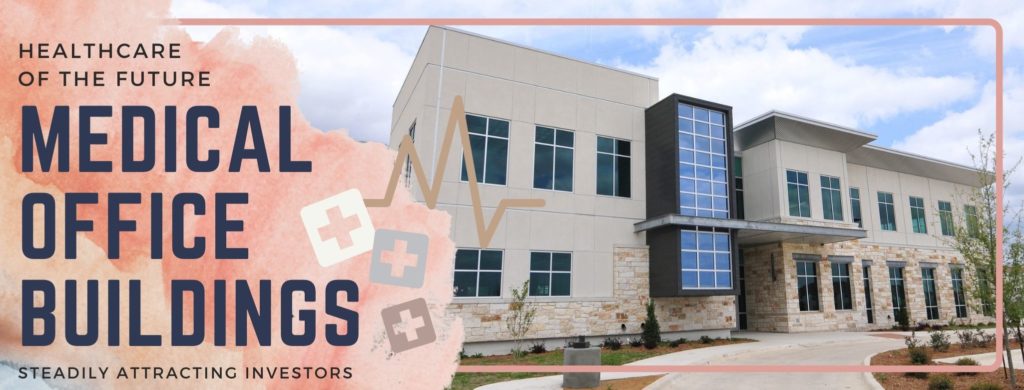Medical office buildings, or MOBs, are office facilities designed specifically for health care practices, with elements or design principles intended to improve patient outcomes and enhance the patient experience.
Over the last three decades the shift away from volume-based care and towards value-based care has been steadily increasing nationwide. In February of 2020, Deloitte posted in a study on Hospital Revenue Trends stating, “In recent years, hospital outpatient revenue has nearly equaled inpatient revenue and is likely to surpass it in the coming years.” They were right.
Technological advances in clinical procedures have enabled outpatient clinics to offer services more efficiently, conveniently, and cost effectively for patients and physicians alike. Many procedures that were previously only available in a hospital setting are now able to be performed safely and effectively in the outpatient setting, and the list of services now offered at these facilities is steadily increasing. Since healthcare affordability remains a hot topic, the decreased overhead of outpatient clinics make them attractive for larger healthcare developers as well as smaller investors. In addition, Medicare and Medicaid are now falling in line, pressuring health systems to take on the value-based model of service, furthering the attractiveness of MOB’s as an investment strategy.
Though covid-19 has influenced the growth of home-based care, telemedicine and other digital services, the necessity of physical care locations has not diminished.
“It’s about the continued need for physical space and the need for patients to continue to be seen,” says CBRE’s Bodnar. “It’s not like retail space. You can decide to stay home from a movie or going out to dinner, but it is very difficult to defer spine surgery or cardiac surgery.”

This continued necessity paired with an increase in consumers’ fear of going to hospitals to receive care has increased the demand for off-campus services and keeping patients away from high-volume, higher-cost locations for care, such as emergency rooms or urgent care facilities has been paramount for operators as well.
With a steadily increasing population requiring physical care locations, and medical groups that need convenient, accessible sites close to their patients, healthcare providers are actively seeking to develop new outpatient facilities and invest in renovations to existing ones making medical office buildings a lucrative investment.
“Healthcare consumers increasingly expect greater accessibility and a better experience when seeking out medical care. In response, healthcare providers continue to develop locations that are easier for patients to access. Outpatient visits to medical office buildings show no signs of slowing down and, due to this growth, MOBs continue to be the most popular property type within the healthcare real estate sector. With fundamentals that are more cycle-resistant than other more traditional property sectors, both tenants and investors are drawn to the consistent stability and positive income growth of MOBs,” said Stephani Gaskins, associate, CBRE.
Motivated by high returns in 2020 and a positive market outlook, investor activity in MOB’s has increased both in new entrants of smaller players as well as by the REIT majority.
“The new infusion of capital into the sector, the favorable lending environment, and a constrained pool of properties available for purchase have created a competitive environment for acquisitions across all risk profiles.” Proclaims Wolf Media.
The bottom line is that people need healthcare and will always need healthcare. The consumer drive toward efficient, convenient, lower cost, higher quality, value-based care, paired with the increased development of MOB’s here in Colorado, indicates this trend in outpatient clinic development will likely continue.

Denver, CO – Recent Medical Office Building Development
Synergy Medical Office Building, a 124,000-square-foot Class AA medical office building on the Swedish Medical Center campus in Englewood, CO delivered in the first half of 2020 with 88.8 percent of the new supply preleased, according to CBRE research.
Orchard Parkway Medical Office Building, a two-story, 75,000-square-foot medical office building including an ambulatory surgery and recovery center, clinical space, diagnostic imaging, physical therapy, urgent care and more than 300 new surface parking stalls in Westminster, CO. Construction of the exterior building and tenant build-outs are expected to complete late 2021 and according to Brinkman Construction there is 1,000 sf still available for lease.
Candelas Medical Offices, a two-story, 44,300-square-foot building for SCL Health in Arvada, CO. Construction is set to complete in July of 2021 with the aim to provide Candelas residents with more convenient access to primary care physicians according to Arvada Press.
Denver Health’s Outpatient Medical Center, a 93,000-square-foot, eight-story building that features eight operating rooms, 220 exam rooms, 37 procedure rooms, a 24-bay chemotherapy infusion clinic, a 23-room dental clinic, a full service radiology lab and pharmacy, nine conference rooms, six classrooms and a 4,800 sf cafe. Construction was completed in November of 2020.
St. Luke’s Medical Center, a 46,517-square-foot interior renovation to accompany exterior renovation at main entrance and buildings, B, PPE, PPW, and Tower A. Renovation scheduled to start April 2021 and continue for 18 months.
Saint Joseph Medical Office Pavilion, a 98,000-square-foot, five-story pavilion that includes three floors dedicated to Class A medical office space, plus 10,000 square feet of ground-level retail and restaurant space. Construction was completed in November of 2020.
Rocky Mountain Family Vision & Colorado Dermatology, a former RiteAid store was redeveloped into a 13,871-square-foot building comprising two Class A medical office condos in Fort Collins, CO. Redevelopment completed in November of 2020.
Health One’s Centennial Hospital, a 67,000-square-foot addition including an operating room, post-anesthesia care unit, and patient suites. The project was completed and the facility opened in March of 2021.
Penrose-St. Francis Health Services, a $150 million, 72 bed hospital plus a medical office building and surgery center on a 57.8 are site at it’s planned third campus at I-25 and Interquest in Colorado Springs, CO. The project’s start has yet to be announced but has a planned completion in January of 2023.
National Jewish Health Center for Outpatient Health, a 104,350-square-foot, 5-story building that includes clinical exam and procedure rooms, a pharmacy, a cafe, and space for ancillary services. This project is slated for completion in fall 2021
UCHealth’s Cherry Creek Medical Center, a 97,000-square-foot, five-story outpatient medical center featuring 70 providers and more than 20 service specialties. It includes a full cancer center with infusion and radiation therapy as well as an imaging center, lab, and retail pharmacy. The medical center was completed in September of 2020.
Centura St. Anthony North, a 70,000-square-foot, two-story orthopedic outpatient facility that will house space for surgery, clinic, physical therapy and imaging. The orthopedic facility is expected to open in spring or summer 2021.
Children’s Hospital Colorado’s Briargate Outpatient Specialty Care, expansion and renovation of many current clinics including the Breathing Institute, gastroenterology, neurology, endocrinology, the Barbara Davis Center for Juvenile Diabetes, and a new pediatric dermatology clinic. Renovations of 16 units completed February 2021 and construction continues on the 27 exam room addition.
Children’s Hospital Colorado Tejon St.Clinic, a 8,500-square-foot outpatient and urgent care location in downtown Colorado Springs, CO. Projections to be open for patients in late 2020 have been pushed back to mid 2022.
Children’s Hospital Colorado Telstar Clinic, a 5,608-square-foot outpatient clinic that will house outpatient therapy services, daytime behavioral health services and developmental pediatrics. Therapies offered at Telstar will include audiology, speech and learning; a sports medicine therapy gym; an outdoor playground recreation area; and additional rehabilitation, physical and occupational therapies. Construction is currently delayed until further notice.
National Jewish Health Outpatient Building, 230,000-square-foot, five-story facility (with parking structure) will include a two-story atrium, have 100 state-of-the-art clinic rooms, an infusion center and diagnostic services. A partnership with SCL Health Saint Joseph Hospital, construction is expected to wrap up in spring 2021.
UCHealth University of Colorado Hospital Tower 3, an addition of 103 patient beds (with the capacity to go up to 200) and nine operating rooms. Tower 3 is expected to be completed in 2022.

Deloitte predicts that this new health economy will drive 85% of revenue as a result of 3 major transformations, number one being the end of the general hospital: “Patients who do need care will likely receive it in highly specialized settings that are tailored to service a specific need rather than being a “one-stop” for all disease states and specialties.” Reports PR Newswire.
What else might the future hold for the MOB market? Perhaps it will be not only a shift toward outpatient clinics in general but also an increase in repurposed buildings (old strip malls, fast food restaurants, hotels and motels, etc.) that will offer drive-thru and in-and-out services. Evidenced by the recent popularity of drive-through COVID-19 testing facilities, the “clinics of the future” may take shape based upon the success of this model and expand to offer drive-up exam rooms, vaccinations, blood draws, and more. All evidence points towards now as the prime time to invest in the future of healthcare.